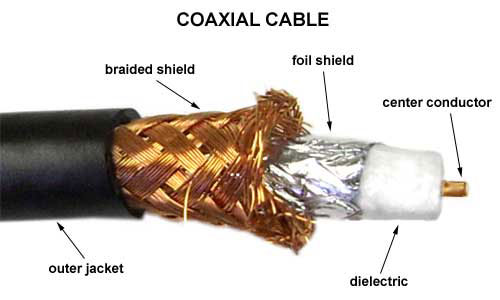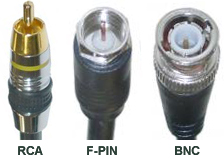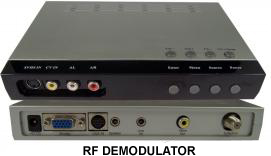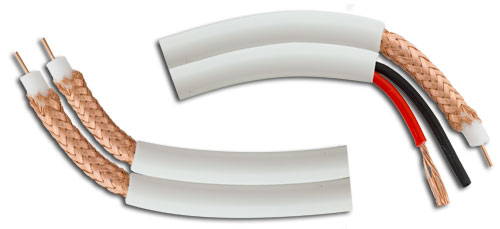Coaxial Corner
Most of us are familiar with coaxial cable being commonly used for cable TV and satellite installations, but it is also used in a variety of other applications. Some of these applications are CCTV (Closed Circuit Television), audio, video, musical interconnects, radio antenna, computer network connections (Cable modems), etc.
Types of Coaxial Cable
- RG58: Largely used in the commercial security camera industry, RG58 cable is a low profile, inexpensive choice for large projects where a high-bandwidth cable is not needed. Most often terminated with BNC connectors, this type of cable can also be found attached to testing equipment and 2-way radio systems.
- RG59: Once the standard for cable TV, RG59 cables are still found packaged with VCRs and televisions. RG59 was a good low-cost option for cable TV for years until the cable industry recently began its move into digital cable television, which needs a thicker cable. Modern satellite television also requires a higher-bandwidth-capable cable and so RG6 coaxial cable is becoming much more popular, making RG59 no longer the industry standard.
- RG6 : RG6 cable is differentiated from RG59 cable by having a thicker copper center conductor. RG6 is primarily being used today for satellite and digital cable TV, where higher frequencies are required that RG59 cable cannot support. RG6 cable is most often sold with F-pin connectors for cable or satellite applications.
- Center Conductor (Bare Copper or Copper Coated) (Solid or Stranded)
- Dielectric Insulator
- Foil Shield
- Braided Shield (Aluminum or Copper)
- Outer Jacket

Each of these components plays a specific role. Let's take a look at each in more detail:
- Center Conductor: At the heart of a coaxial cable is a center conductor. Typically constructed of either pure copper (in higher-end cables) or copper-coated steel or aluminum (in less-expensive cables), the center conductor is responsible for transmitting the cable's signal. As such, it must meet certain electrical properties (such as wire resistance). The rest of the cable construction is primarily designed to help the center conductor maintain its electrical integrity.
- Dielectric Insulator: The dielectric insulator's purpose is two-fold; first, it acts as an insulator between the center conductor and the outer braided / foil shielding. Second, it helps physically hold the center conductor in the center of the cable. This is important, as signal loss can occur if the center conductor strays too close to the outer area of the cable. Various materials are commonly used for the dielectric. A few of the more common materials, in order of quality (from best to worst), are below:
- Foamed Polyethylene (FPE)
- Teflon
- Polyethylene (PE)
- Polypropylene (PP)
- Polyvinylchloride (PVC)
- Braided Shield: Long copper cables have a tendency to act like antennas, picking up stray signals from the environment. These unwanted signals, known as "interference", disrupt the signal that the cable is supposed to be carrying. Interference tends to come in two different flavors: electromagnetic interference (known as EMI) and radio frequency interference (RFI). EMI interference is often caused by heavy power lines, cell phone signals, etc. A braided shield protects the signal from EMI interference. When looking at cable specs, the braided shield will often be expressed in a percent coverage, which often ranges anywhere from 30% to 95% coverage. The higher the coverage, the better the protection.
- Foil Shield: Although not always present on coaxial cables, the foil shield serves to protect from RFI interference. Foil shields are almost always made out of aluminum foil, and simply wrap around the inner parts of the cable. Unlike braided shields, which have a percent coverage, foil shields always cover 100%.
- Outer Jacket: The outer jacket is generally made out of flexible PVC (polyvinyl chloride) and serves primarily to hold the cable together and protect it from the elements.
Connectors
There are many different connectors that can terminate a coaxial cable. We will now go over a few of the more common connectors.

- RCA: The RCA connector was developed in the early 1940s by the Radio Corporation of America to connect record players to amplifiers. The same basic connector is still in wide use today, and it represents a large portion of the connectors used for home theater cables. The fact that they are so easy to connect and disconnect makes RCA connectors a popular choice for home theater applications. RCA cables can be used for audio, video and digital audio. The biggest drawback with RCA devices is that each signal is sent on a different cable. For example, a single RCA-terminated coax cable only carries the left audio channel, or only the right, etc. Three RCA cables are needed for high-def video, along with two more for the audio. This makes for a mess of cables behind your equipment. This is one reason that has made HDMI cables so popular. Attaching RCA connectors can be a bit more time-consuming as, with some types of RCA connectors, the coaxial cable's wires need to be soldered to the connector after stripping the cable with a stripping tool . RCA connectors come in solder-on, weatherproof and compression styles. A special tool is required for compression connectors, and a soldering iron is needed for solder-on connectors.

- BNC: The BNC connector has two bumps on the female side that slide into corresponding grooves on the male side. The connector is then rotated a quarter turn to lock into place. BNC connectors are widely used in commercial applications such as closed circuit television systems, where its ability to lock in place (unlike the slip-on RCA) makes BNC cables a perfect fit. BNC connectors come in a wide variety as well, including twist-on and weatherproof connectors.
- F-Pin: The F-pin connector is probably the most recognized of the coaxial connectors as it's been in use with televisions and VCRs for decades. The familiar threaded connector makes for a secure connection that will not easily slip out of a device. This connector is also one of the easiest to attach to a coax cable as it does not require any soldering. Many different types are available including twist-on, crimp-on and compression. For outdoor use, weatherproof connectors are also available to create an F-Pin cable with a secure connection and loss-less signal transfer. Many manufacturers are doing away with the F-pin connector on their TVs. This is because that little F-pin connector is actually part of a device called a tuner. The tuner is what sifts through the signal coming through the cable and separates all of the TV channels. Since so many people change channels using a cable box or satellite receiver, these tuners are becoming obsolete. This can pose a problem for folks who have standard cable TV that still requires the TV to have an F-pin connector. Unfortunately, a small adapter or special cable won't do the trick. A tuner is required. There are a couple ways to do this. One way is to use an old VCR. VCRs have built in tuners. The other way is to use a device called an RF demodulator . A demodulator is essentially a TV tuner that will let you change the channels.

In geometry, the term coaxial means that two or more forms share a common axis. In the case of coaxial cable it is when the inner conductor and the outer shield share the same geometric axis. In the illustration below the x and y axes are shown, the point where they meet is the z axis. Note how both the outer shield and the inner conductor share the z axis as a center point.

Coaxial cable is the most common cable used as a transmission line, transmitting electrical energy or signal from one place to another. It comes in a large variety, typically identified by impedance and/or RG-type. RG (Radio Guide) is a generic term (WWII United States military specifications) that is used to identify a large variety of cable designs. It is commonly followed by a number.
The more commonly used RG-types are RG6 and RG59 . These two types are commonly used in Cable TV, satellite and CCTV applications. Both have an impedance of 75 ohms, a characteristic common to video and audio equipment for its low attenuation.
RG59 is a single shielded coaxial cable about 6.1 mm in diameter with a smaller center conductor than your standard RG6 cable. Although RG59 can be used for cable TV applications (CATV), there is a significant amount of signal loss over higher frequencies when run at longer distances. RG59 is typically used to carry baseband video in CCTV applications .
Today RG6 is the more commonly used RG-type. RG6 is used in a variety of applications, both residential and commercial. RG6 is typically a double shielded coaxial cable about 6.86mm in diameter with a center conductor a bit larger than that of the RG59 type. RG6 is commonly used in Cable TV, Satellite TV and Cable Modem applications due to its low attenuation over high frequencies.
Both RG6 and RG59 come in a variety of types, which are all designed for specific applications. Below is a list of eight commonly used coaxial designs for a typical video distribution application:

- Flooded/Direct Burial: Flooded/ Direct Burial coaxial cable is designed for installation inside underground conduits. It is used in cable TV applications as a transmission line from the signal source to the customer's home. Some flooded cable contains a sticky gel-like substance for heavier waterproofing.

- Indoor/Outdoor: Indoor / Outdoor (Interior/Exterior) coaxial cable is not based on any specific RG type, it is a basic coaxial cable. Jacket ratings differentiate the two. White is usually chosen as interior coaxial cable due to the fact that most homes or dwellings will use white trim around the base of the floor. This design is primarily based on aesthetics, and is solely a customer's preference. Black coaxial cable will also work for interior installations. Black is often used in an interior space when run between walls of a single dwelling home or an apartment building. Black is also used outdoors primarily for aesthetics. When installed underneath the eve on the exterior wall of a single dwelling home, black tends to be less visible. Coaxial cable designed for outdoor use will also have a (UV) rated jacket for protection against sun exposure.
- Plenum: Plenum rated (CMP) coaxial cable comes in a variety of RG types but is differentiated by its outer jacket. Plenum rated coaxial cable is designed using a special Teflon material for the outer jacket. This cable is required for runs involving ventilation ducts and is designed to meet fire codes.
- Riser: Riser rated (CMR) coaxial cable comes in a variety of RG types and is used in vertical tray applications when installing between floors through cable risers or in elevator shafts. It is for non-plenum spaces.
- RG11: RG11 is a triple or quad shielded coaxial cable about 10.5 mm in diameter and is used for long runs, in both aerial and underground conduit. RG11 coax operates at an impedance of 75 ohms and is suitable for video distribution. It finds additional usage in cable TV installations where the distance from the TAP splitter to the customer's home is longer than 250 ft in length. RG11 is a lot thicker than your RG6 and RG59 types and has a larger center conductor allowing for low attenuation at longer distances.

Coaxial cable has a plethora of connectors for termination. As was briefly explained earlier in the article, coaxial cable is a multi purpose cable used in a number of applications. Connectors come in many different types and sizes relative to each coaxial series. Some of the more common coaxial terminations are F-pin and BNC . Both F-pin and BNC connectors are referred to as RF (Radio Frequency) connectors and operate at impedance of 75 ohms. F-pin connectors are found in cable TV, Satellite TV and cable modem installations. BNC connectors are used in closed circuit television/surveillance camera, networking and HDSDI (High Definition Serial Digital Interface) applications. Both F-pin and BNC connectors can be found in a variety of termination types (crimp-on, twist-on, solder, or compression). Another well-known connector type used to terminate coaxial cable is the RCA connector. The RCA connector, also known as a phono connector, is commonly used to carry audio and or video signals from a variety of musical equipment and audio/visual hardware. (Televisions, cable boxes, mixers, audio receivers, speakers, amplifiers, etc.). You can refer to our previous article " Coaxial Cables " for further detail on the connectors mentioned in this article.

Coaxial cables can also be used with a variety of hardware and adapters. Some of the more common pieces of equipment used in conjunction with some of the more common coaxial designs are passive devices such as splitters , F-pin couplers(Barrels), Diplexers, etc.
Coaxial cable is like the Swiss Army knife of cables. Its many personalities allow it to adapt and be applicable to today's society and its needs. It will remain relevant for the foreseeable future due to its low cost and ability to transmit high quality signal. I hope that we have been able to answer many of your questions on the subject of coaxial cable.
No comments:
Post a Comment